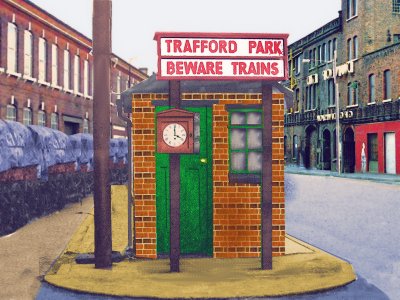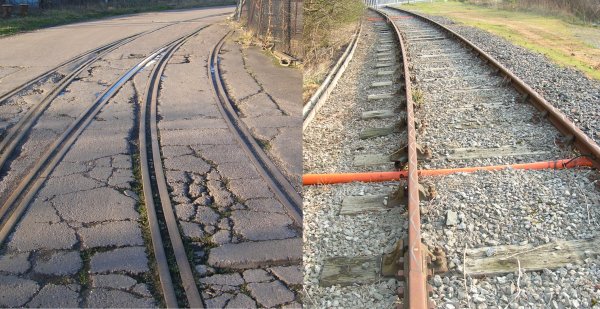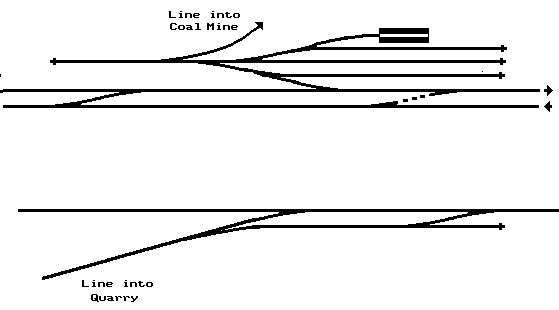Industrial Sidings & Industrial Railways
Some things were common to all industrial or private railway sidings; they must by law be gated where they join the main railway's property and private locomotives would not have travelled onto the railway proper. The most common rail connection was for just a siding or two running alongside the main line into the factory premises. This is handy as the 'factory' itself can form part of the back-scene and need not use up valuable space on the layout.
The railways had by law to be fenced off so where the siding left the railway line it passed through a gate. If this gate was in the perimeter fence of the industry being served the gate was often left open. Similarly factories are fenced off for good reasons, preventing theft for example, so even when located some distance from the railway main line the entrance for the siding would normally have a gate. Where the siding crossed a road between the railway and the industry gates were occasionally provided (the junction with the railway was always gated of course). Where the line crossed a road as it meandered through a town a man with a red flag would stop the road traffic when the train was crossing. This man travelled on the locomotive, often standing on the foot-step at the front and hanging on to the hand rail on the side of the boiler or engine housing. Inside industrial estates and dock areas there was often no fence round the railway lines but this was not as much of a problem as you might imagine as shunting was restricted to specific times and traffic flows were usually regular.
Where privately owned railway lines crossed open areas with property belonging to others to either side they would be fenced off as for normal railways. One example of this kind of line might be the internal railway system connecting a number of coal pits or lines from chalk or limestone quarries feeding a cement works.
In large industrial estates or docks the tracks were often not fenced off at all, at the entrance to Trafford Park, a large industrial estate in outh Manchester, there was a large sign on the main entrance road saying 'BEWARE TRAINS'. The train tracks entered the area beside the road but once inside the estate they routinely crossed roads with only signs for protection. In the sketch below a train of sheeted wagons is entering the area on the left, having crossed a main road on an ungated industrial crossing. Once inside the estatre the lines were not fenced off.
Fig___ Entrance to Traffod Park industrial estate

The brick building behind the sign is a bus inspectors shelter, the cased clock on the post supporting the sign was for the use of the bus inspectors who checked the timekeeping of the services feeding the area. Up to the 1970s there were literally hundreds of busses involved in the morning and evening rush hours here.
Inside the estate the tracks were often inset, although where the line ran beside a road rather than along it the track was of conventional appearance.
Fig___ Tracks on a large industrial estate

Exchange Sidings
Industries that are by their nature dispersed, such as the mines in a coal field, often had tracks which meandered some distance across open country. These linked the various parts of the industry together, connection to the national rail network being at a set of 'exchange sidings' on the main railway line. The exchange sidings were arranged so that the railway company locos could deposit wagons from rest of the system and collect loaded wagons. The works engines would then shunt the stock between the works and the exchange sidings without having to move onto the railway proper. This is convenient for modelling purposes as the works itself might consist of a backdrop, or even be `off stage' forming part of a hidden fiddle yard.
Fig ___ Exchange sidings

Exchange sidings offer plenty of scope for restrained clutter; a small hut for filling in waybills, another for tools and odds and ends, a few gas lamps and perhaps a short raised platform used for transferring heavy items from railway stock to internal use wagons are all possible additions. The works side of the sidings might contain clues as to the nature of the works itself, for example a couple of rusty five foot lengths of six foot diameter tube lying on the ground at a pipe works.
Fiddle Sidings & Loops
One problem with modelling industries such as coal mines on a layout is that we would not normally see rakes of empty wagons leaving or rakes of loaded wagons arriving. This applies to several industries such as steel works and brick works but is less of a problem where the goods were conveyed in vans or routinely covered, such as flour mills, jam factories etc.
The American Clinchfield exhibition layout features a coal mine and a power station with trains of coal passing from the mine to the power station and trains of empty wagons making the reverse journey. This is accomplished by having a pair of hidden spiral tracks inside a mountain connecting the coal mine on one side with the power station on the other. Loaded trains leave the mine, traverse the layout and enter the power station where they descend the spiral ready to emerge once more 'freshly loaded' at the mine. A similar train of empty wagons meanwhile makes the reverse journey and with careful timing the illusion of loaded coal trains going one way and returning empties going the other was effective.
On a British outline layout, if it can be arranged for tracks to disappear behind the back-scene, we can feed them through to a fiddle/exchange yard at the rear. This allows rakes of empty wagons to go under the loading arrangement and full wagons to be pulled back out. In a domestic layout adding a single hidden track behind the back scene right round the layout and connected to a fiddle yard would allow stock to work realistically from a number of industrial premises.
Fig ___ Industrial fiddle-track
When modelling an industry it does help to have some idea of the materials and processes involved and the colours of anything which might litter, dust or splash onto wagons and equipment.
^
Go to top of page
International Good Guys ~ Making the world a
better place since 1971 ~ Site maintained by

All material Copyright © Mike
Smith 2003 unless otherwise credited


